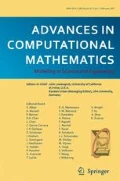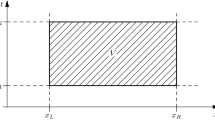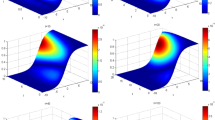Abstract
This paper deals with the Hessian discretisation method (HDM) for fourth-order semi-linear elliptic equations with a trilinear non-linearity. The HDM provides a generic framework for the convergence analysis of several numerical methods, such as the conforming and nonconforming finite element methods (ncFEMs) and methods based on gradient recovery (GR) operators. The Adini ncFEM and GR method, a specific scheme that is based on cheap, local reconstructions of higher-order derivatives from piecewise linear functions, are analysed for the first time for fourth-order semi-linear elliptic equations with trilinear non-linearity. Four properties, namely, the coercivity, consistency, limit-conformity and compactness, enable the convergence analysis in HDM framework that does not require any regularity of the exact solution. Two important problems in applications, namely, the Navier–Stokes equations in stream function vorticity formulation and the von Kármán equations of plate bending, are discussed. Results of numerical experiments are presented for the Morley and Adini ncFEMs, and the GR method.
Similar content being viewed by others
References
Ben-Artzi, M., Croisille, J.-P., Fishelov, D.: A high order compact scheme for the pure-streamfunction formulation of the Navier-Stokes equations. J. Sci Comput. 42(2), 216–250 (2010)
Brenner, S.C., Gu, S., Gudi, T., Sung, L.-Y.: A quadratic C0 interior penalty method for linear fourth order boundary value problems with boundary conditions of the Cahn-Hilliard type. SIAM J. Numer. Anal. 50(4), 2088–2110 (2012)
Brenner, S.C., Neilan, M., Reiser, A., Sung, L.-Y.: A C0 interior penalty method for a von Kármán plate. Numer Math. 135(3), 803–832 (2017)
Brezzi, F.: Finite element approximations of the von Kármán equations. RAIRO Anal. Numér. 12(4), 303–312 (1978)
Brezzi, F., Rappaz, J., Raviart, P.-A.: Finite-dimensional approximation of nonlinear problems. I. Branches of nonsingular solutions. Numer. Math. 36(1), 1–25 (1980)
Carstensen, C., Gallistl, D., Hu, J.: A posteriori error estimates for nonconforming finite element methods for fourth-order problems on rectangles. Numer. Math. 124(2), 309–335 (2013)
Carstensen, C., Mallik, G., Nataraj, N.: A priori and a posteriori error control of discontinuous Galerkin finite element methods for the von Kármán equations. IMA J. Numer. Anal. 39(1), 167–200 (2019)
Carstensen, C., Mallik, G., Nataraj, N.: Nonconforming finite element discretization for semilinear problems with trilinear nonlinearity. IMA Journal of Numerical Analysis, drz071, https://doi.org/10.1093/imanum/drz071 (2020)
Chueshov, I., Lasiecka, I.: Von Karman Evolution Equations: Well-posedness and long-time dynamics. Springer Monographs in Mathematics. Springer, New York (2010)
Ciarlet, P.G.: The Finite Element Method for Elliptic Problems. Studies in Mathematics and its Applications, vol. 4. North-Holland Publishing Co., Amsterdam-New York-Oxford (1978)
Ciarlet, P.G.: Mathematical Elasticity. vol. II Theory of plates, volume 27 of Studies in Mathematics and its Applications. North-Holland Publishing Co., Amsterdam (1997)
Di Pietro, D.A., Ern, A.: Mathematical Aspects of Discontinuous Galerkin Methods, volume 69 of Mathématiques & Applications (Berlin) [Mathematics & Applications]. Springer, Berlin (2012)
Droniou, J., Eymard, R., Gallouët, T., Guichard, C., Herbin, R.: The Gradient Discretisation Method, Volume 82 of Mathématiques & Applications (Berlin) [Mathematics & Applications]. Springer, Cham (2018)
Droniou, J., Lamichhane, B.P., Shylaja, D.: The Hessian discretisation method for fourth order linear elliptic equations. J. Sci. Comput. 78(3), 1405–1437 (2019)
Evans, L.C.: Partial Differential Equations, Volume 19 of Graduate Studies in Mathematics. American Mathematical Society, Providence, RI (1998)
Gallistl, D.: Morley finite element method for the eigenvalues of the biharmonic operator. IMA J. Numer. Anal. 35(4), 1779–1811 (2015)
Girault, V., Raviart, P.-A.: Finite Element Approximation of the Navier-Stokes Equations, Volume 749 of Lecture Notes in Mathematics. Springer-Verlag, Berlin New York (1979)
Grisvard, P.: Singularities in Boundary Value Problems, Volume 22 of Recherches en Mathématiques Appliquées [Research in Applied Mathematics]. Masson, Paris. Springer-Verlag, Berlin (1992)
Lamichhane, B.P.: A mixed finite element method for the biharmonic problem using biorthogonal or quasi-biorthogonal systems. J. Sci. Comput. 46 (3), 379–396 (2011)
Lamichhane, B.P.: A finite element method for a biharmonic equation based on gradient recovery operators. BIT 54(2), 469–484 (2014)
Lascaux, P., Lesaint, P.: Some nonconforming finite elements for the plate bending problem. Rev. Française Automat. Informat. Recherche Operationnelle Sér Rouge Anal. Numér. 9(R-1), 9–53 (1975)
Lions, J.-L.: Quelques méthodes de résolution des problémes aux limites non linéqires. Dunod; Gauthier-Villars, Paris (1969)
Mallik, G., Nataraj, N.: Conforming finite element methods for the von Kármán equations. Adv Comput. Math. 42(5), 1031–1054 (2016)
Mallik, G., Nataraj, N.: A nonconforming finite element approximation for the von Kármán equations. ESAIM Math. Model. Numer Anal. 50 (2), 433–454 (2016)
Miyoshi, T.: A mixed finite element method for the solution of the von Kármán equations. Numer. Math. 26(3), 255–269 (1976)
Shylaja, D.: Numerical methods for elliptic partial differential equations and optimal control problems. Doctoral dissertation, IITB-Monash Research Academy (2019)
Shylaja, D.: Improved L2 and H1 error estimates for the Hessian discretization method. Numer. Methods Partial Differential Equations (2020)
Temam, R.: Navier-Stokes equations. Theory and numerical analysis. Studies in Mathematics and its Applications. North-Holland Publishing Co., Amsterdam-New York-Oxford, Vol 2 (1977)
Acknowledgements
The authors gratefully acknowledge Prof. Dietmar Gallistl, Friedrich-Schiller-Universität Jena, for providing MATLAB codes for Adini ncFEM for the biharmonic problem.
Funding
The work of the first author was partially supported by the Australian Government through the Australian Research Council’s Discovery Projects funding scheme (project number DP170100605). The second author was supported by DST SERB MATRICS grant MTR/2017/000199 and MHRD SPARC project (ID 235). The third author received financial support from the National Board for Higher Mathematics, India, towards the research work (No.: 0204/3/2020/R&D-II/2476).
Author information
Authors and Affiliations
Corresponding author
Additional information
Communicated by: Francesca Rapetti
Publisher’s note
Springer Nature remains neutral with regard to jurisdictional claims in published maps and institutional affiliations.
Appendix. Proof of the properties associated with ncFEMs and GR method
Appendix. Proof of the properties associated with ncFEMs and GR method
This section deals with the proofs of the properties associated with the ncFEMs and GR methods stated in Theorems 4.5 and 4.6. For notational convenience, the first three properties are proved using the generic notation \({\mathcal {D}}\) (without index).
1.1 A.1 Nonconforming FEM
The preliminaries below are useful to prove the convergence of the Adini and Morley HDM for non-linear equations.
Let hσ denote the diameter of σ and for all \(w \in H^{1}({\mathcal M})\) (the broken Sobolev space H1 on the mesh), define \(\Vert {{\cdot }}\Vert _{dG,{\mathcal M}}\) by
Lemma A.1
[12, Theorems 5.3, 5.6] Let ℓ ≥ 0 be a non-negative integer. It holds
-
(i) [Discrete Sobolev embedding] For all \(v_{h} \in \mathbb {P}_{\ell }({\mathcal M})\), \(\Vert {v_{h}}\Vert _{L^{4}} \lesssim \Vert {v_{h}}\Vert _{dG,{\mathcal M}}.\)
-
(ii) [Discrete Rellich theorem] Let \(({\mathcal M}_{m})_{m\in \mathbb {N}}\) be sequence of regular triangular or rectangular meshes, whose diameter hm tend to 0 as \(m\to \infty \). For all \(m\in \mathbb {N}\), let \(v_{m}\in \mathbb {P}_{\ell }({{\mathscr{M}}}_{m})\). If \((\Vert {v_{m}}\Vert _{dG,{{\mathscr{M}}}_{m}})_{m\in \mathbb {N}}\) is bounded, then, for all 1 ≤ q < 2∗ (where 2∗ is a Sobolev exponent of 2), the sequence \((v_{m})_{m\in \mathbb {N}}\) is relatively compact in Lq(Ω).
-
(iii) [27, Lemma 6.2] Let \(w\in H^{1}({\mathcal M})\). If for all \({\sigma } \in {\mathcal {F}}\) there exists xσ ∈ σ such that ⟦w⟧(xσ) = 0, then \(\Vert {w}\Vert _{dG,{\mathcal M}} \lesssim \Vert {\nabla _{{\mathcal M}}w}\Vert .\)
Lemma A.2
[14, 27] Let \({\mathcal D}\) be a HD for the Morley (resp. Adini) ncFEM in the sense of Definition 3.2 (resp. Definition 3.3). Then,
We now prove the four properties associated with the Morley and Adini ncFEMs.
Proof of Theorem 4.5
(i) The Morley element.
-
(i)
Let \(v_{{\mathcal D}} \in X_{{\mathcal D},0}\). Since \(\llbracket \nabla _{{\mathcal D}} v_{{\mathcal D}} \rrbracket =0\) at the midpoints of the edges, Lemma A.1(i) and Lemma A.1(iii) lead to
$$ \Vert{\nabla_{\mathcal D} v_{\mathcal D}}\Vert_{L^4} \lesssim \Vert{\nabla_{\mathcal D} v_{\mathcal D}}\Vert_{dG,{\mathcal M}} \lesssim \Vert{{\mathcal{H}}_{{\mathcal D}}v_{\mathcal D}}\Vert. $$(A.1)The combination of this and Lemma A.2(i) prove \(C_{{\mathcal D}} \lesssim 1\).
-
(ii)
For \(\varphi \in H^{3}({\Omega })\cap {H^{2}_{0}}({\Omega })\), the standard interpolant [10, 21] satisfies
$$ \begin{array}{@{}rcl@{}} &\Vert{I_{h}\varphi-\varphi}\Vert\lesssim h^{3} \Vert{\varphi }\Vert_{H^{3}({\Omega})}, \Vert{\nabla_{{\mathcal{M}}} I_{h}\varphi-\nabla \varphi}\Vert_{L^{4}} \lesssim h^{\frac{3}{2}} \Vert{\varphi}\Vert_{H^{3}({\Omega})}, \\ &\text{ and }\Vert{{\mathcal{H}}_{{\mathcal M}} I_{h}\varphi-{\mathcal{H}}\varphi}\Vert \lesssim h \Vert{\varphi }\Vert_{H^{3}({\Omega})}. \end{array} $$(A.2)Hence, selecting \(w \in X_{{\mathcal D},0}\) corresponding to the degrees of freedom of Ihφ in the definition of \(S_{{\mathcal D}}(\varphi )\) yields the result on consistency.
-
(iii)
For all \({K} \in {\mathcal M}\) and for any \({\sigma } \in {{{\mathcal {F}}}_K}\), denote the unit vector normal to σ outward K by nK, σ. An integration by parts shows
$$ \begin{array}{@{}rcl@{}} \left| {\int}_{{\Omega}} \left( \nabla_{{\mathcal D}} v_{{\mathcal D}} \cdot \phi + {\Pi}_{{\mathcal D}} v_{{\mathcal D}} \text{div} \phi \right)\text{d}\boldsymbol{x} \right|& =\left|\underset{{K} \in {\mathcal M}}{\sum}\underset{{\sigma} \in {{{\mathcal{F}}}_K}}{\sum} {\int}_{{\sigma}}(\phi \cdot n_{{K},{\sigma}}){\Pi}_{{\mathcal D}} v_{{\mathcal D}} \text{d} s(\boldsymbol{x})\right|. \end{array} $$(A.3)The proof of the result on \(\widehat {W}_{{\mathcal D}}\) then follows from a slightly modified version of [21, Lemma 3.5]. However, for the sake of completeness, we provide a proof. Let V1 be the space of all globally continuous piecewise linear functions and let \({\Pi }_{1}:V_{h} \rightarrow V_{1}\) be the interpolation operator such that π1vh equal to vh at the vertices of all triangle K, vh ∈ Vh. Then
$$ \underset{{K} \in {\mathcal M}}{\sum}\underset{{\sigma} \in {{{\mathcal{F}}}_{K}}}{\sum} {\int}_{{\sigma}}^{}(\phi \cdot n_{{K},{\sigma}}){\Pi}_{\mathcal D} v_{\mathcal D} \text{d} s(\boldsymbol{x})=\underset{{K} \in {\mathcal M}}{\sum}\underset{{\sigma} \in {{{\mathcal{F}}}_{K}}}{\sum} {\int}_{{\sigma}}P(v_h-{\Pi}_1{v_h})\text{d} s(\boldsymbol{x}), $$(A.4)where P = ϕ ⋅ nK, σ and \(v_{h}={\Pi }_{{\mathcal D}} v_{{\mathcal D}}\). Note that a change of variables yields
$$ {\int}_{{\sigma}\in {{{\mathcal{F}}}_{K}}}P(v_h-{\Pi}_1{v_h})\text{d} s(\boldsymbol{x})=|{\sigma}|{\int}_{\hat{{\sigma}} \in {\mathcal F}_{\hat{{K}}}}\widehat{P}(\widehat{v_h}-\widehat{{\Pi}_1}{\widehat{v_h}})\text{d} s(\boldsymbol{x}), $$(A.5)where \({\widehat {{K}}}\) is the reference finite element. The continuous trace inequality [12], the discrete trace inequality [12, Lemma 1.46], an interpolation estimate [10] and Young’s inequality show
$$ \left|{\int}_{\widehat{{\sigma}} \in {\mathcal F}_{\widehat{{K}}}}\widehat{P}(\widehat{v_{h}}-{\Pi}_{1}{\widehat{v_{h}}})\text{d} s(\boldsymbol{x})\right|\lesssim \left( |{\widehat{P}}|_{0,\hat{K}}+|{\widehat{P}}|_{1,\widehat{K}}\right)|{\widehat{v}}|_{2,\widehat{K}}, $$where \(|\cdot |_{\ell ,\widehat {K}}\) denotes the seminorm on \(H^{\ell }(\widehat {K})\), ℓ ≥ 0. Substitute the above estimate in (A.5), transform from \(\widehat {K}\) to K using \(|\hat {\psi }|_{\ell ,\hat {K}} \lesssim h^{\ell -1}|\psi |_{\ell ,K}\) for ψ ∈ Hℓ(K) ([10, Theorem 3.1.2]), sum over all the edges and then use (A.4) to obtain
$$ \begin{array}{@{}rcl@{}} \left|\underset{{K} \in {\mathcal M}}{\sum}\underset{{\sigma} \in {{{\mathcal{F}}}_{K}}}{\sum} {\int}_{{\sigma}}^{}(\phi \cdot n_{{K},{\sigma}}){\Pi}_{{\mathcal D}} v_{{\mathcal D}} \text{d} s(\boldsymbol{x})\right|\lesssim (h \Vert{\phi}\Vert+h^{2} \Vert{\nabla\phi}\Vert )\Vert{{\mathcal{H}_\mathcal{D}} v_{{\mathcal D}}}\Vert. \end{array} $$This in (A.3) reads
$$ \left| {\int}_{{\Omega}} \left( \nabla_{{\mathcal D}} v_{{\mathcal D}} \cdot \phi + {\Pi}_{{\mathcal D}} v_{{\mathcal D}} \text{div} \phi \right)\text{d}\boldsymbol{x} \right|\lesssim (h \Vert{\phi}\Vert+h^{2} \Vert{\nabla\phi}\Vert)\Vert{{\mathcal{H}_\mathcal{D}} v_{{\mathcal{D}}}}\Vert. $$The above estimate with Lemma A.2 leads to the required estimate on \(\widehat {W}_{{\mathcal {D}}}\) and \(W_{{\mathcal {D}}}\) and thus establish limit-conformity.
-
(iv)
Let a sequence \(u_{m} \in X_{{\mathcal D}_{m},0}\) be such that \((\Vert {u_{m}}\Vert _{{\mathcal D}_{m}})_{m \in \mathbb {N}}\) is bounded. Since \(\llbracket {\Pi }_{{\mathcal D}_{m}} u_{m} \rrbracket \) = 0 at the edge vertices, Lemma A.1(iii) and estimate (A.1) yield \( \Vert {{\Pi }_{{\mathcal {D}}_m} u_{m}}\Vert _{dG,{\mathcal M}_{m}} \lesssim \Vert {\nabla _{{\mathcal {D}}_m} u_{m}}\Vert \lesssim \Vert {\nabla _{{\mathcal {D}}_m} u_{m}}\Vert _{L^{4}}\lesssim \Vert {{{\mathscr{H}}}_{{\mathcal {D}}_m}u_{m}}\Vert .\) At the edge midpoints \(\llbracket \nabla _{{\mathcal {D}}_m} u_{m} \rrbracket =0\) and consequently, Lemma A.1(iii) with \(w=\nabla _{{\mathcal {D}}_m} u_{m}\) shows \( \Vert {\nabla _{{\mathcal {D}}_m} u_{m}}\Vert _{dG,{\mathcal M}_{m}}\) \(\lesssim \Vert {{{\mathscr{H}}}_{{\mathcal {D}}_m}u_{m}}\Vert .\) Use the fact that \((\Vert {u_{m}}\Vert _{{\mathcal D}_{m}})_{m \in \mathbb {N}}\) is bounded to deduce \(({\Pi }_{{\mathcal D}_{m}}u_{m})_{m \in \mathbb {N}}\) and \((\nabla _{{\mathcal D}_{m}}u_{m})_{m \in \mathbb {N}}\) are bounded in the \(\Vert {\cdot }\Vert _{dG,{\mathcal M}_{m}}\) norm. Lemma A.1(ii) then gives the relative compactness of \(({\Pi }_{{\mathcal D}_{m}}u_{m})_{m \in \mathbb {N}}\) in L2(Ω), and of \((\nabla _{{\mathcal D}_{m}}u_{m})_{m \in \mathbb {N}}\) in \(L^{4}({\Omega };{\mathbb {R}}^{d})\).
(ii) The Adini element.
-
(i)
Since \(\nabla _{{\mathcal D}} v_{{\mathcal D}}\) is continuous at the vertices of elements in \({\mathcal M}\) and \(\nabla _{{\mathcal D}} v_{{\mathcal D}}\) vanish at vertices along ∂Ω, \(\llbracket \nabla _{{\mathcal D}} v_{{\mathcal D}} \rrbracket =0\) at the vertices. As a consequence, Lemma A.1 (i)–(iii) leads to \( \Vert {\nabla _{{\mathcal D}} v_{{\mathcal D}}}\Vert _{L^{4}} \lesssim \Vert {\nabla _{{\mathcal D}} v_{{\mathcal D}}}\Vert _{dG,{\mathcal M}} \lesssim \Vert {{{\mathscr{H}}}_{{\mathcal D}}v_{{\mathcal D}}}\Vert .\) This and Lemma A.2 concludes that \(C_{{\mathcal D}} {\lesssim 1}\).
-
(ii)
The standard interpolant satisfies (A.2) and hence yields the desired estimate on the consistency measure \(S_{{\mathcal D}}\).
-
(iii)
Any \({\sigma } \in {\mathcal F}\) is associated to a fixed orientation of the unit normal vector nσ on σ. For \(K \in {\mathcal M}\) and \({\sigma }\in {\mathcal F}_{K}\), set nσ := nK, σ. Apply integration by parts in each cell to obtain
$$ \left| {\int}_{{\Omega}} \left( \nabla_{{\mathcal D}} v_{{\mathcal D}} \cdot \phi + {\Pi}_{{\mathcal D}} v_{{\mathcal D}} \text{div} \phi \right)\text{d}\boldsymbol{x} \right|=\left|\underset{{\sigma} \in {\mathcal F}}{\sum} {\int}_{{\sigma}}^{}(\phi \cdot n_{\sigma})\llbracket {\Pi}_{{\mathcal{D}}} v_{{\mathcal{D}}} \rrbracket \text{d} s(\boldsymbol{x})\right|. $$Here, the jump has been chosen in a compatible way with the orientation determined by nσ. Since \({\Pi }_{{\mathcal {D}}} v_{{\mathcal {D}}} \in {H^{1}_{0}}({\Omega })\cap C(\overline {{\Omega }})\), \(\llbracket {\Pi }_{{\mathcal D}} v_{{\mathcal D}} \rrbracket =0\), which implies \(\widehat {W}_{{\mathcal D}}(\phi )=0\). This and Lemma A.2 yields an estimate on the limit-conformity measures, namely \(\widehat {W}_{{\mathcal D}}\) and \(W_{{\mathcal D}}\).
-
(iv)
The compactness proof follows as for the Morley element using the fact that \(\llbracket {\Pi }_{{\mathcal D}} v_{{\mathcal D}} \rrbracket =0\) and \(\llbracket \nabla _{{\mathcal D}} v_{{\mathcal D}} \rrbracket =0\) at the vertices.
□
Rights and permissions
About this article
Cite this article
Droniou, J., Nataraj, N. & Shylaja, D. Hessian discretisation method for fourth-order semi-linear elliptic equations: applications to the von Kármán and Navier–Stokes models. Adv Comput Math 47, 20 (2021). https://doi.org/10.1007/s10444-020-09837-4
Received:
Accepted:
Published:
DOI: https://doi.org/10.1007/s10444-020-09837-4
Keywords
- Hessian discretisation
- Navier–Stokes equations
- von Kármán equations
- Plate bending
- Non-linear equations
- Finite element
- Gradient recovery
- Convergence




